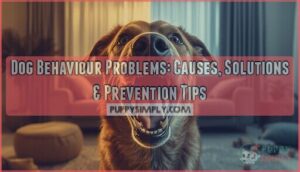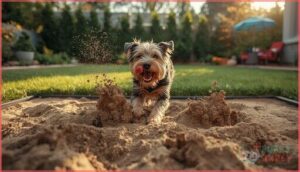This site is supported by our readers. We may earn a commission, at no cost to you, if you purchase through links.
Your dog isn’t broken, but that incessant barking at 3 AM might break your sanity. Over 41% of dog owners report excessive barking as a daily frustration, yet most behavior problems aren’t signs of a “bad dog”—they’re signals of unmet needs, miscommunication, or underlying stress.
The good news is that dog behaviour problems rarely appear without a reason, and understanding what drives them gives you the power to transform your household from chaotic to calm. Whether you’re dealing with separation anxiety that’s shredding your furniture or leash pulling that’s dislocating your shoulder, the right strategies can address the root causes instead of just managing symptoms.
Table Of Contents
- Key Takeaways
- Most Common Dog Behavior Problems
- Causes Behind Dog Behavior Issues
- Solutions for Everyday Behavior Problems
- Advanced Behavior Modification Techniques
- Preventing Future Behavior Problems
- Frequently Asked Questions (FAQs)
- What are common dog behavior issues?
- What causes bad dog behavior?
- What happens if a dog develops a bad behavior?
- What are common behavioral issues in dogs and cats?
- Are ‘Bad’ Dogs a problem?
- How do you deal with dog behavior problems?
- How to deal with dog behavior problems?
- What are the symptoms of behavioral disorders in dogs?
- What is a red flag dog’s behavior?
- What calms an aggressive dog?
- Conclusion
Key Takeaways
- Over 99% of dogs show at least one moderate to serious behavior problem, with separation anxiety affecting 85.9% of U.S. dogs and excessive barking troubling 41.1% of owners, meaning these issues are nearly universal rather than signs of a “bad dog.”
- Most behavior problems stem from identifiable causes like insufficient exercise, inadequate early socialization during the critical 3-14 week window, underlying medical conditions (which account for 28-82% of behavioral issues), or environmental stressors rather than deliberate misbehavior.
- Positive reinforcement training proves more effective than punishment-based methods, with reward-trained dogs responding correctly about 77% of the time, while advanced cases benefit from combining behavior modification techniques like desensitization with veterinary support including medication when needed.
- Prevention through early puppy socialization, consistent household rules, daily mental and physical enrichment (220-250 minutes of exercise weekly), and regular veterinary health monitoring stops problems before they develop and protects against relinquishment or euthanasia risks.
Most Common Dog Behavior Problems
Dog behavior problems show up in nearly every household with a pet, and chances are you’ve dealt with at least one of these issues yourself. A 2025 study of over 43,000 dogs found that 99% displayed at least one moderate to serious behavior problem, which means you’re not alone in this struggle.
Let’s look at the most common challenges dog owners face and what they actually mean for your daily life.
Excessive Barking
Why does your dog turn every doorbell or siren into a full-blown concert? Excessive barking tops the list of dog behavior problems—Japanese surveys found 41.1% of owners troubled by barking at indoor noises. Addressing excessive howling involves understanding bark acoustics, noise nuisance levels reaching 90 decibels, and legal limits defining persistent vocalization. One potential solution involves addressing the dog’s anxiety related barking with medication.
Here’s what triggers the racket:
- Unfamiliar visitors approaching your home
- Sudden household or street sounds
- Boredom from lack of mental stimulation
- Territorial instincts protecting their space
- Anxiety or heightened arousal states
Intervention outcomes show systematic training reduces barking considerably within weeks.
Separation Anxiety
While barking annoys neighbors, separation anxiety in dogs cuts deeper—it’s the distress your pet feels when you’re gone. In the U.S., 85.9% of dogs show moderate to severe separation-related behaviors, making this the most widespread behavior problem you’ll face. Anxiety prevalence surged 760% post-pandemic, affecting young adults aged one to five most often.
Physiological features include elevated heart rates and cortisol spikes during isolation. Video studies confirm that longer absences—two to four hours versus thirty minutes—intensify whining, pacing, and door scratching. Dogs with separation anxiety are also 4.1 times more likely to be hyperactive and 2.8 times more prone to generalized fear, revealing comorbid traits.
Risk factors cluster around single-person households, working breeds, and neutered status. Noise sensitivity often accompanies separation-related distress, so addressing separation anxiety in dogs means tackling multiple triggers at once. Veterinary professionals recognize the need for medical intervention alongside behavioral changes.
Managing separation anxiety combines behavior modification with medication when needed. Randomized trials show clomipramine shortens recovery time and boosts long-term success. Treatment efficacy peaks when you pair environmental tweaks, structured routines, and professional guidance—multi-modal plans outperform single strategies every time.
Owner impact runs deep: 58% of guardians feel guilty leaving pets alone, 14% cite financial strain, and 17% report relationship tension. Untreated cases risk relinquishment or euthanasia, underscoring why early intervention protects both your dog’s welfare and your peace of mind.
Untreated separation anxiety inflicts guilt on over half of dog owners and threatens the bond that keeps pets in homes
| Sign | What It Looks Like |
|---|---|
| Destructive behavior | Chewed furniture, scratched doors, torn cushions |
| Vocalization | Continuous howling, barking, whining when alone |
| House soiling | Urination or defecation despite prior house training |
Destructive Chewing
While anxiety tears your bond apart, destructive chewing in dogs can wreck your home just as fast. In 2025, 17.7% of dogs regularly gnawed furniture or household objects, and 3.6–4% needed veterinary care for injuries from chewing.
Puppies chew during the Puppy Teething Stage, but anxiety-related chewing also peaks when you leave. Breed Chewing Tendencies and insufficient Chew Toy Variety increase the damage, especially in adolescents aged six to eighteen months.
Aggression and Biting
Beyond torn cushions lies a more urgent threat: aggression and biting. In the U.S., over 333,000 people visit emergency departments yearly for dog bites, averaging 914 injuries daily. Managing dog aggression starts with recognizing breed-specific risks and bite severity.
Children face the highest danger, accounting for 70% of bite-related deaths.
Prevention strategies, early socialization, and professional behavior modification reduce both legal liabilities and public safety threats.
Inappropriate Elimination
Despite your patience with other dog behavior problems, house soiling tops the complaint list at 20% of behavior consultations. Inappropriate elimination stems from three main drivers: medical etiologies like urinary tract infections, training deficits from incomplete house training, and anxiety triggers during owner absence.
Prevention strategies using positive reinforcement yield excellent treatment prognosis—83% of cases improve when you implement structured outdoor schedules and reward correct elimination immediately.
Pulling on The Leash
With over 80% of companion dogs tugging their handlers forward, pulling on the leash ranks as the most common walking problem you’ll encounter. This behavior increases injury risk for you—54% of leash-related emergency visits result from being pulled—and concentrates harmful pressure on your dog’s neck when using collars.
Training techniques emphasizing front-clip harnesses and positive reinforcement improve leash manners while protecting both handler and canine from musculoskeletal strain.
Jumping on People
Greeting behaviors spark jumping on people in over 90% of household dogs, with excitement triggers amplifying this behavior problem before walks and during arrivals. Size differences matter—smaller dogs jump more on household members, while males show higher rates than females.
Training techniques using “four paws on the floor” and withholding attention effectively reduce jumping up, though safety risks from falls and injuries make intervention essential for larger dogs.
Digging and Yard Destruction
Your dog’s excavation project might look like mischief, but instinctive digging runs deep in many breeds—terriers and huskies dig by design.
Around 24% of dogs show frequent digging behavior in confined spaces, often signaling boredom or breed tendencies.
Redirecting behavior to a designated digging area with environmental enrichment and digging solutions helps prevent destructive dog behavior while respecting your dog’s natural need to dig holes.
Causes Behind Dog Behavior Issues
Your dog’s behavior doesn’t happen in a vacuum. Every time your dog barks too much, chews up your couch, or refuses to listen, there’s usually a reason behind it.
Let’s look at the most common causes that trigger these frustrating behaviors so you can pinpoint what’s really going on.
Lack of Exercise and Stimulation
Exercise deficits fuel many dog behavior problems you’ll encounter. When your dog doesn’t burn enough energy or engage their mind, boredom and frustration take over, often leading to destructive behavior. Here’s what insufficient exercise and mental stimulation commonly cause:
- Excessive barking and whining from pent-up energy
- Chewing furniture and household items out of boredom
- Increased fearfulness and reactivity toward strangers or other dogs
- Weight gain and physical health decline from inactivity
Activity patterns matter—dogs spending too much time alone without proper outlets develop more severe issues.
Inadequate Training or Socialization
Without proper early socialization during that narrow critical window—roughly 3 to 14 weeks, your puppy misses key chances to build confidence around unfamiliar dogs and people. Lack of structured puppy training classes sharply increases fear-based aggression and relinquishment risk later.
In fact, dogs with insufficient socialization showed fear of strangers in nearly half of surveyed cases, underscoring serious welfare consequences that proper behavior prevention can address.
Medical and Health Conditions
Training and socialization gaps explain many dog behavior problems, yet a hidden driver often goes unnoticed—your dog’s health. Pain comorbidities, endocrine disorders, cognitive decline, neurological issues, and sensory impairment silently fuel aggression, house soiling, and anxiety. Clinical data reveal that 28 to 82 percent of behavioral issues stem from an underlying medical condition. Before you blame bad habits, see your vet:
- Chronic pain triggers irritability and reduced activity
- Hypothyroidism causes lethargy and social withdrawal
- Epilepsy increases anxiety between seizures
- Hearing loss strongly predicts disorientation
- Diabetes leads to house soiling from excessive urination
Environmental Stress and Changes
Physical ailments aren’t the only silent disruptor—your dog’s environment plays an equally powerful role. Urban noises like fireworks trigger fear responses in 77 percent of dogs, while housing transitions from kennels to homes spark anxiety and destructive behavior.
Routine predictability matters: inconsistent schedules increase cortisol and worsen behavioral issues. Social environment shifts strain both you and your pet.
Fortunately, enrichment buffers these stressors, lowering stress hormones and calming anxious dogs.
Breed Predispositions
Beyond external pressures, genetics hardwire certain dog behavior problems. Genetic heritability for aggression traits reaches 68 percent in some breeds—Dachshunds and Chihuahuas bite more often than Golden Retrievers.
Cooperative breeds like herding dogs show heightened anxiety levels and separation distress, while noise sensitivity affects up to half of all canines.
Understanding these breed predispositions helps you anticipate and manage canine behavior issues rooted in dog instincts, not poor training alone.
Solutions for Everyday Behavior Problems
Once you understand why your dog is acting out, the next step is fixing it. The good news is that most everyday behavior problems respond well to straightforward training methods that don’t require expensive tools or years of experience.
Below are five proven approaches that work for the issues most dog owners face on a daily basis.
Positive Reinforcement Training
Rewarding the behavior you want is the most effective way to solve dog behavior problems. Positive reinforcement training works better than punishment-based methods, with studies showing dogs trained through rewards respond correctly about 77% of the time on the first cue.
Use treats, praise, or clicker training to shape behavior. Lure training helps teach new commands, and practicing in different settings builds generalization skills for lasting behavior modification.
Redirecting Unwanted Behaviors
When your dog starts a problem behavior, shift their focus to something appropriate instead. Redirection works by interrupting the unwanted action and guiding your dog toward a better choice, with improvements seen in over 40% of cases when applied consistently.
- For destructive chewing: Offer safe chew toys with different textures to satisfy the urge constructively
- For barking triggers: Redirect attention to obedience commands or interactive play before arousal escalates
- For jumping alternatives: Guide your dog into a sit position, then reward calm greetings immediately
Basic Obedience and Socialization
Training your dog to respond to obedience commands like “sit,” “stay,” and “come” builds the foundation for managing dog behavior problems.
Early socialization during puppyhood—especially between 3 and 12 weeks—reduces fear and aggression later on. Puppy classes that combine social exposure with positive reinforcement produce dogs that are less fearful and more responsive, preventing many issues before they start.
Providing Proper Outlets for Energy
Meeting your dog’s physical and mental needs is one of the most powerful ways to prevent dog behavior problems. Most dogs require 30 to 60 minutes of daily exercise—walking, running, or structured activities like agility—to reduce destructive chewing and hyperactivity.
When dogs lack adequate outlets, health risks such as obesity and joint disease increase, while mental stimulation through puzzle toys keeps their minds sharp.
Managing Triggers in The Home
You can’t fix what keeps setting your dog off if you don’t control the environment. Noise reduction starts with silencing high-frequency sounds—smoke alarms and beeps stress 82.5% of dogs more than constant hums.
Visual barriers like curtains block window reactivity, while safe spaces and doorbell management prevent rehearsal of barking.
Routine predictability anchors behavior modification, identifying triggers for barking and resolving dog behavior problems systematically.
Advanced Behavior Modification Techniques
Some behavior problems won’t respond to basic training alone, especially when deep-rooted anxiety or aggression is involved. In these cases, you’ll need to step up your approach with methods that reshape your dog’s emotional response to triggers.
Let’s look at the sophisticated techniques that can make a real difference when standard solutions fall short.
Desensitization and Counterconditioning
When your dog freezes at fireworks or panics when you grab your keys, you’re witnessing fear that behavior modification can reshape. Desensitization and counterconditioning are clinical protocols proven to address noise phobias, separation anxiety, and fear aggression by gradually exposing your dog to triggers below their reaction threshold while pairing them with rewards.
Evidence outcomes show these dog behavior modification techniques work—when you start small, stay patient, and build new emotional associations.
Working With Professional Trainers
You can’t fix every behavior problem alone—and you shouldn’t have to. In a 2024 UK survey, 42% of dog owners consulted a professional trainer or canine behaviorist for at least one issue. When choosing help, look for:
- Trainer qualifications like CCPDT certification, ensuring standardized competency
- Reward-based dog training methods that avoid confrontational techniques linked to aggression
- Technology integration through apps designed by veterinary professionals to extend guidance between sessions
Case outcomes improve when referral pathways connect you to credentialed experts early.
Medication and Veterinary Support
When behavior training alone isn’t enough, your vet can prescribe psychotropic medications that target anxiety and compulsive behaviors. Veterinary behaviorists combine antidepressants like fluoxetine or tricyclic antidepressants with behavior treatment, improving outcomes by up to 22 percentage points.
Short-term anxiolytics help dogs cope during specific stressful events. Medication integration with training tackles dog health issues that training can’t fix by itself.
Creating Predictable Routines
Beyond medication and structured training, your dog needs a stable daily routine to see real progress. Feeding schedules, exercise consistency, and sleep patterns give anxious dogs a sense of control. Research shows that fixed daily routines cut stress-related behaviors by half.
Alone-time training becomes easier when your dog knows what to expect. Consistency is how dog behavior modification works—it anchors dog training in predictable patterns that reduce anxiety and tackle dog behavior problems at their root.
Preventing Future Behavior Problems
Stopping problems before they start is always easier than fixing them later. You can set your dog up for success by taking a few key steps early on and sticking with them throughout their life.
Here are the most effective ways to prevent behavior issues from developing in the first place.
Early Training and Socialization
By three weeks, your puppy’s senses are ready to learn. The socialization window—roughly three to fourteen weeks—closes permanently, so structured puppy classes and varied home environment exposures during this period shape adult behavior more than any later training.
Dogs attending formal classes respond better to commands and show less aggression toward strangers. Balancing risks with positive reinforcement in dog training for beginners builds confidence without overwhelming your pup.
Ensuring Consistent Rules
Once your puppy learns the basics, household alignment determines whether those lessons stick. Dogs living under predictable routines show up to 70% higher reliability in responding to commands, while inconsistent rules—one person allowing jumping, another correcting it—spike anxiety and confusion.
Lock in success with:
- Cue consistency: use identical words and hand signals across all family members
- Timing consequences: reward or redirect within one to two seconds
- Routine predictability: feed, walk, and train at similar times daily
- Welfare retention: stable expectations reduce stress-related behaviors and strengthen your bond
Consistent training isn’t rigid—it’s fair, and your dog will thank you for it.
Providing Mental and Physical Enrichment
Weaving cognitive stimulation into your dog’s daily routine cuts behavior problems before they start. Dogs receiving structured play sessions, puzzle toys, and varied social interaction show measurable stress reduction and fewer unwanted behaviors.
Aim for 220 to 250 minutes of exercise weekly, mixing physical activity with problem-solving tasks. This dual approach—mental stimulation plus dog exercise—keeps minds sharp, bodies tired, and trouble at bay.
Regular Health Checks and Monitoring
Routine vet visits catch medical problems that quietly fuel dog behavior issues—and most dogs need professional evaluation at least once yearly. Pain, dental disease, and organ dysfunction often show up as aggression, house soiling, or lethargy before obvious physical signs appear.
- Schedule annual wellness exams for health screening and pain detection
- Track your dog’s activity, appetite, and elimination patterns at home through owner monitoring
- Use tech monitoring tools like smart collars to flag subtle changes in life signs
- Request orthopedic and dental assessments if your dog’s temperament shifts unexpectedly
Weaving consistent vet check-ins into your pet care routine protects dog health, dog wellbeing, and behavior long-term.
Frequently Asked Questions (FAQs)
What are common dog behavior issues?
You’ve probably noticed your dog acting out—maybe they’re tearing up furniture, lunging at strangers, or barking nonstop.
These common dog behavior problems, from anxiety triggers to aggression types, stem from identifiable causes.
What causes bad dog behavior?
Bad behavior often stems from lack of exercise, training deficits, health factors, or stressful environments. Breed genetics also play a role.
Understanding dog behavior and communication helps you address these common dog behavior problems effectively.
What happens if a dog develops a bad behavior?
Left unaddressed, behavior escalation becomes a ticking time bomb—welfare compromise deepens, owner stress mounts, and relinquishment risk climbs.
Correcting behavior problems early protects your dog from euthanasia likelihood while addressing canine behaviors preserves your bond.
What are common behavioral issues in dogs and cats?
Canine behavior problems affect nearly all dogs, with separation anxiety impacting 9% and aggression documented in 6%. Cats show different patterns—7% have owner-reported issues, primarily anxiety, scratching furniture, and house-soiling problems.
Are ‘Bad’ Dogs a problem?
Yes. Over 99% of dogs show problematic behaviors, and more than half exhibit aggression.
These common dog behavior issues drive shelter relinquishments and bite-related costs exceeding $795 million yearly, highlighting owner responsibility over breed stereotypes.
How do you deal with dog behavior problems?
The best training starts by doing less—identifying your dog’s behavior problems requires stepping back first.
Then consistency, environmental management, and seeking support turn everyday corrections into long-term strategies that actually work.
How to deal with dog behavior problems?
Addressing canine behaviors requires a combination of behavior modification, consistent training techniques, and proper home management.
For persistent issues, professional help or medication options may be necessary to achieve lasting behavior correction and improve your dog’s quality of life.
What are the symptoms of behavioral disorders in dogs?
Anxiety symptoms include panting, pacing, trembling, and hiding. Aggression signs often appear alongside fear-based body language.
Compulsive behaviors like tail-chasing and excessive licking can cause self-harm.
Depressive symptoms include withdrawal, sleep disturbances, and appetite changes.
What is a red flag dog’s behavior?
Think of a dog’s behavior as a telegraph from an earlier era—subtle signals warn before trouble strikes. Red flags include persistent growling, stiff freezing, lunging, resource guarding, and extreme fear reactions that may escalate into aggression.
What calms an aggressive dog?
Managing dog aggression requires relaxation training, behavior modification like desensitization, and sometimes calming medications under veterinary guidance.
Owner consistency, sensory aids, and professional support help address fear aggression and reduce aggressive dog behavior effectively.
Conclusion
Your dog won’t read this article or suddenly discover meditation, so the work falls on you. But here’s the upside: addressing dog behaviour problems doesn’t require a PhD in animal psychology—just consistency, patience, and the willingness to see barking and chewing as communication, not defiance.
Start with one issue, apply what fits your situation, and remember that progress beats being ideal. Your calmer home is worth the effort.
- https://phys.org/news/2025-04-dogs-behavior-problem.html
- https://www.newsweek.com/more-99-percent-dogs-have-behavior-problems-united-states-2055388
- https://modernsciences.org/dog-behavior-issues-us-aggression-anxiety-study-april-2025/
- https://papers.ssrn.com/sol3/papers.cfm?abstract_id=5374383
- https://pmc.ncbi.nlm.nih.gov/articles/PMC7058607/



















